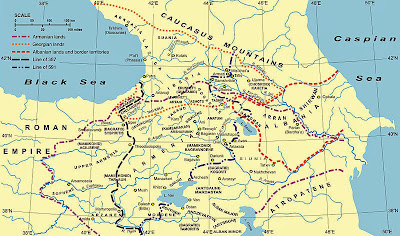Albania (Latin: Albānia, Greek: Ἀλβανία, Albanía,,in Old Armenian: Աղուանք Ałuankʿ (Aguank),Parthian: Ardhan, Middle Persian: Arran; usually referred to as Caucasian Albania for disambiguation with the modern state of Albania; the native name for the country is unknown is a name for the historical region of the eastern Caucasus, that existed on the territory of present-day republic of Azerbaijan (where both of its capitals were located) and partially southern Dagestan.
After the rise of the Parthian Empire the kings of Caucasian Albania were replaced with a Arsacid family and would later be succeeded by another Iranian royal family in the 5th century AD, the Mihranids.The Parthian name was Ardhan (Middle Persian: Arran). The Arabic was ar-Rān.. The name of the country in the language of the native population, the Caucasian Albanians, is not known..
Aghuank (Old Armenian: Աղուանք Ałuankʿ, Modern Armenian: Աղվանք Aġvank’) is the Armenian and the most historically referenced name[citation needed] for Caucasian Albania. Armenian authors mention that the name derived from the word "ału" («աղու») meaning amiable in Armenian. The term Aghuank is polysemous and is also used in Armenian sources to denote the region between the Kur and Araxes rivers as part of Armenia. In the latter case it is sometimes used in the form "Armenian Aghuank" or "Hay-Aghuank"..
The Armenian historian of the region, Movses Kaghankatvatsi, who left the only more or less complete historical account about the region, explains the name Aghvank as a derivation from the word ału (Armenian for sweet, soft, tender), which, he said, was the nickname of Caucasian Albania's first governor Arran and referred to his lenient personality.[14] Movses Kaghankatvatsi and other ancient sources explain Arran or Arhan as the name of the legendary founder of Caucasian Albania (Aghvan) or even of the Iranian tribe known as Alans (Alani), who in some versions was a son of Noah's son Yafet.[15] James Darmesteter, translator of the Avesta, compared Arran with Airyana Vaego[16] which he also considered to have been in the Araxes-Ararat region,[17] although modern theories tend to place this in the east of Iran.http://en.wikipedia.org/


No comments:
Post a Comment